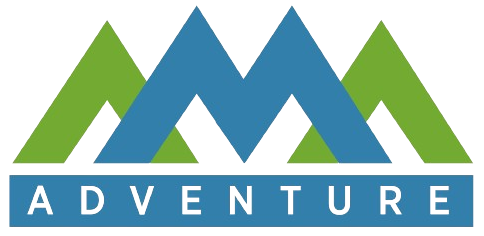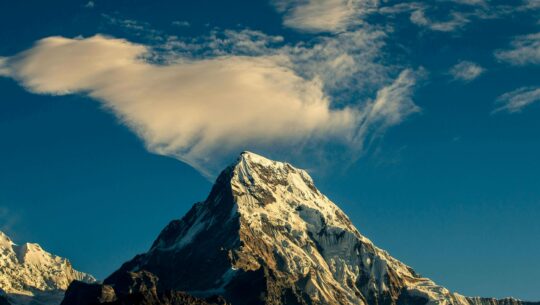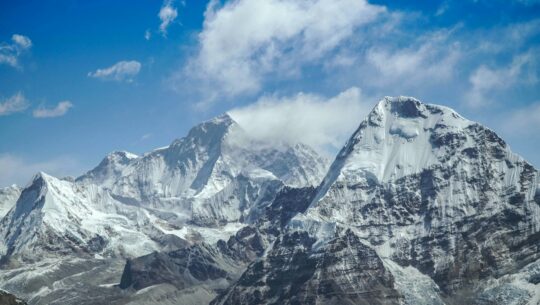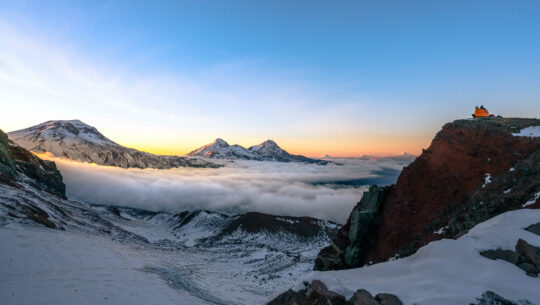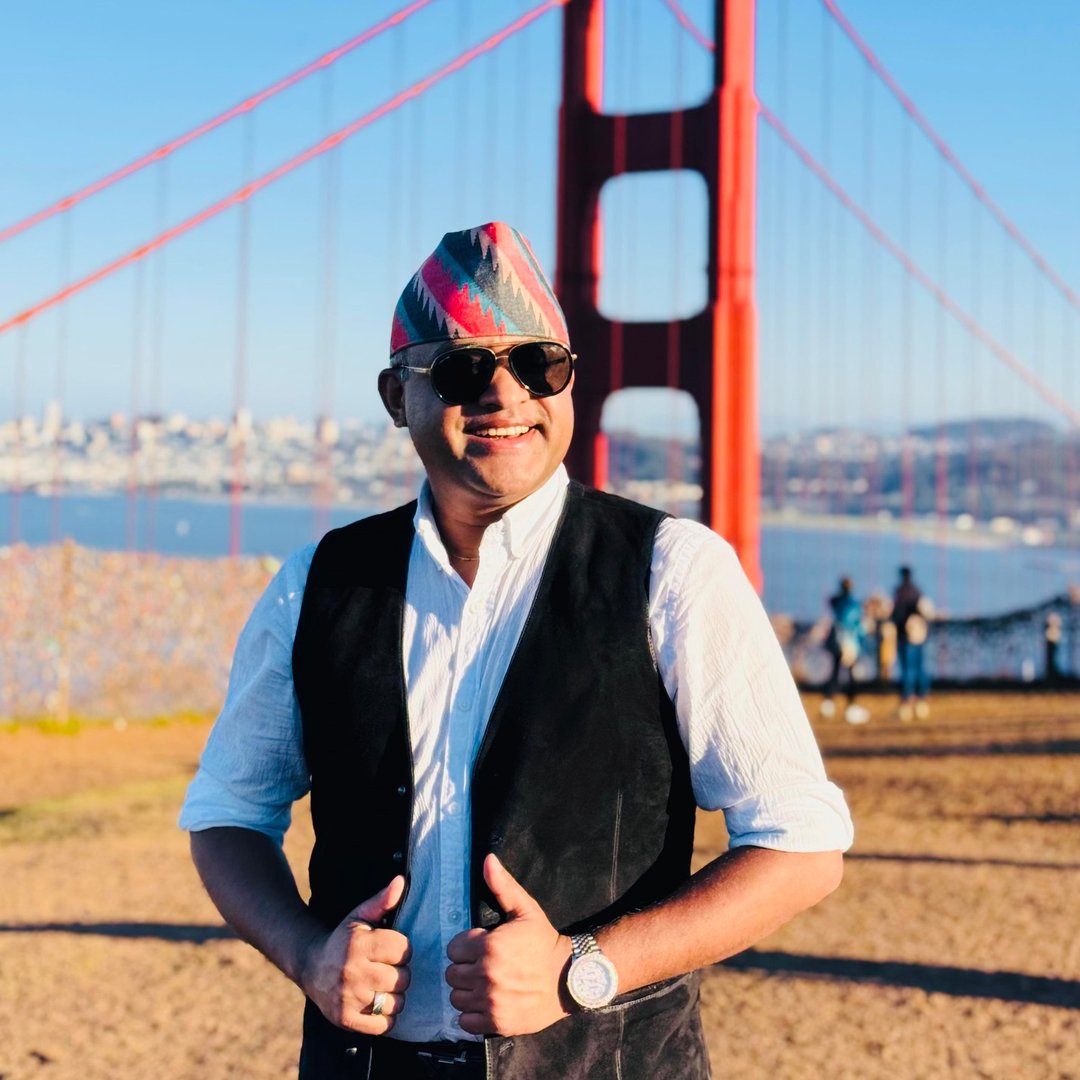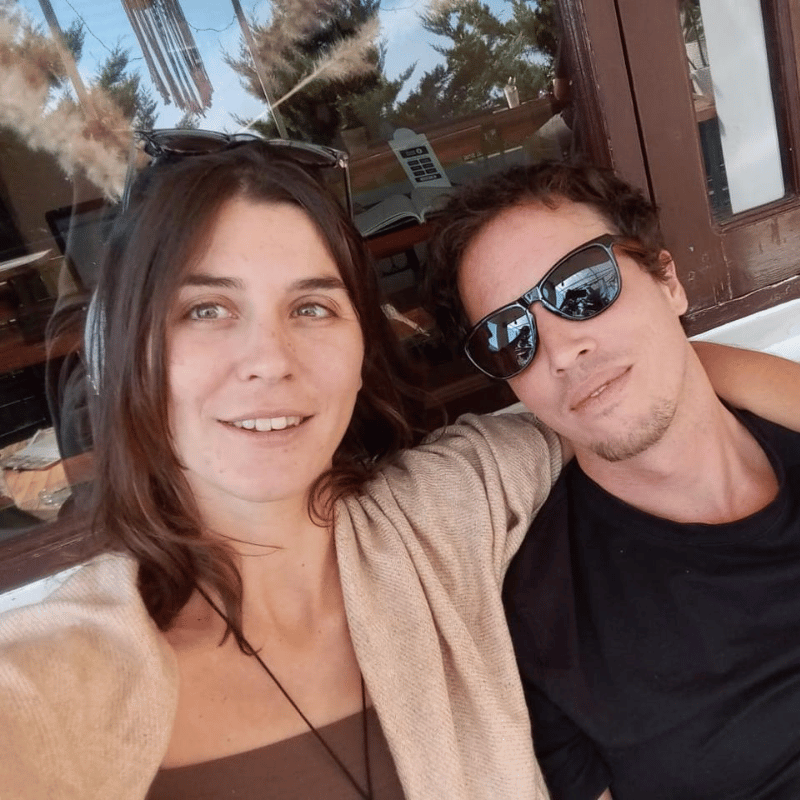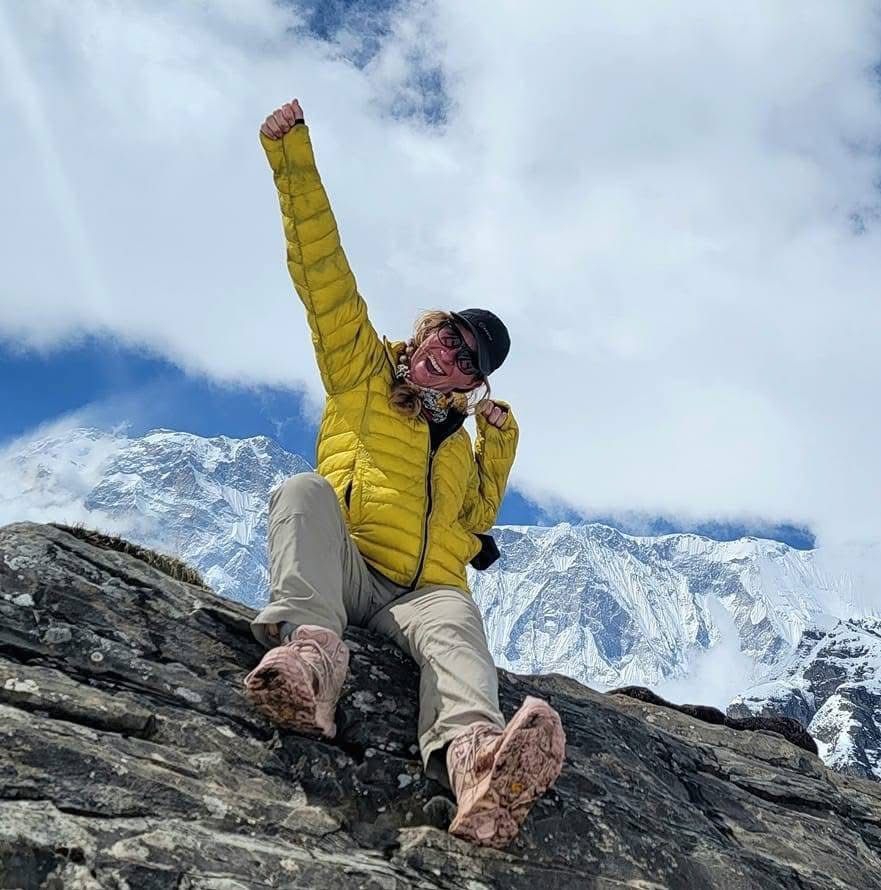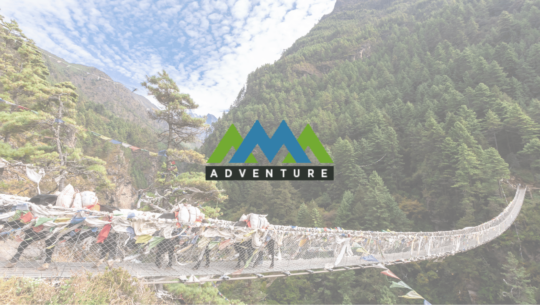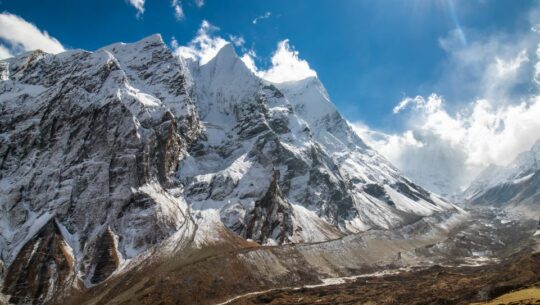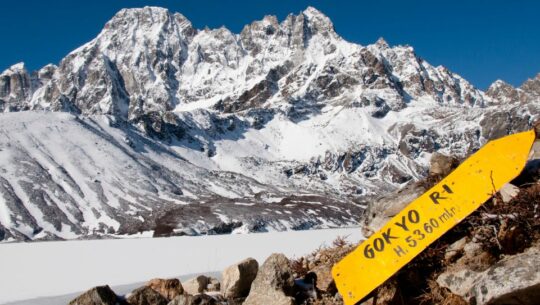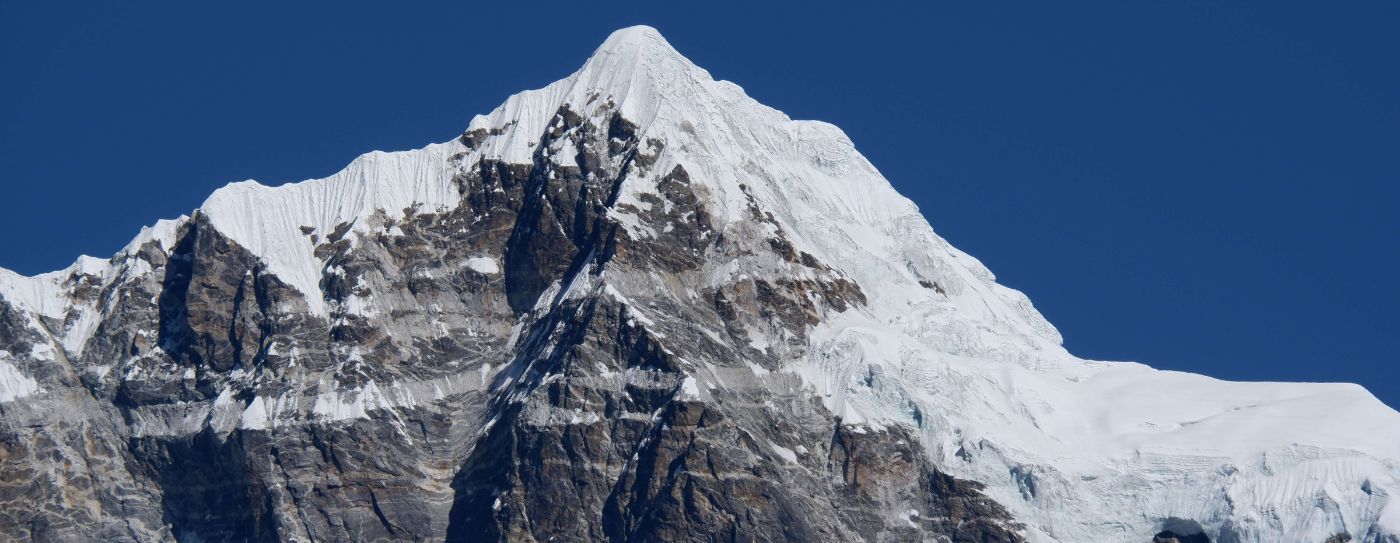
Everest Base Camp Trek-14 Days
Experience an unforgettable adventure through the trails of the Khumbu region, surrounded by breathtaking views of towering peaks and the majestic Mt. Everest, the highest mountain in the world.
Nepal
14 Days
Strenuous
5,555 m / 18,225 ft
March–May, September–November
Tea Houses & Hotels
Included
Kathmandu
USD 1543
Trip Highlights
- Set out on an unforgettable journey to the foot of the world’s tallest mountain- Everest Base Camp.
- Soak in the breathtaking aerial views of the towering Himalayas on the flight to Lukla.
- Walk through the pristine landscapes of Sagarmatha National Park.
- Explore Namche Bazaar, the vibrant gateway and cultural hub of the Everest region.
- Experience the rich traditions and warm hospitality of the Sherpa community.
- Enjoy panoramic Himalayan vistas from the renowned Hotel Everest View- one of the highest-altitude hotels.
- Visit the sacred Tengboche Monastery, the oldest and most significant monastery in the Everest region.
- Witness the awe-inspiring Khumbu Glacier and the dramatic Khumbu Icefall.
- Trek to the scenic viewpoints of Kala Patthar (5,555 m) and Nangkartshang Peak (5,083 m).
- Marvel at the majestic views of Mt. Everest, Ama Dablam, Lhotse, Nuptse, Thamserku, Cho Oyu, and many other towering peaks.
Trip Overview
The Everest Base Camp trek offers a perfect mix of well-established trails and the untouched beauty of the Himalayas. Set in the heart of the Everest region, this journey showcases breathtaking mountain landscapes and the warm hospitality of the Sherpa community. It’s not just a trek to the base of the highest peak in the world- it’s also a deep dive into Nepal’s culture and highland traditions.
This 14-day adventure reaches an altitude of around 5,364 meters, where trekkers are rewarded with sweeping views of towering peaks like Pumori, Lhotse, Nuptse, Lobuche, and of course, the mighty Mt. Everest.
Your journey begins with a scenic 35-minute flight from Kathmandu to Lukla during the months of January, February, June, July, August, and December. During peak seasons (March, April, May, October, and November), flights operate from Manthali/Ramechhap to Lukla, which involves a 5-6 hour drive from Kathmandu followed by a 20-minute flight.
The trail starts and ends in Lukla, following the banks of the Dudh Koshi River and passing through Sagarmatha National Park. Namche Bazaar, an important trade hub in the region that serves as a vital acclimatization stop and offers an early glimpse into Sherpa culture.
Though physically demanding, the trek is filled with rewarding sights-green hills, terraced fields, dense forests, and towering peaks. From Namche, we head towards Tengboche, where we visit the iconic Tengboche Monastery before continuing to Dingboche and then Lobuche. Along the way, the views of majestic peaks like Ama Dablam, Lhotse, Nuptse, Makalu, and Cho Oyu continue to inspire.
The trail then takes us to Gorak Shep, from where we walk along the edge of the Khumbu Glacier to reach Everest Base Camp. This glacier is one of the deepest in the world, which adds to the dramatic scenery. We return to Gorak Shep for the night.
Early the next morning, we hike to Kala Patthar for a spectacular sunrise over Mt. Everest and the surrounding peaks. After enjoying the view, we make our way back to Gorak Shep and descend to Pheriche.
The return journey follows the same route back through Tengboche and Namche Bazaar. Once in Lukla, a flight back to Kathmandu marks the end of this incredible Himalayan journey.
Outline Itinerary
- Day 1: Arrival in Kathmandu and Transfer to Hotel (1,400 m / 4,593 ft)
- Day 2: Travel to Lukla and Trek to Phakding (2,840 m / 9,318 ft) from Kathmandu- approx. 35 minutes
- Day 3: Phakding to Namche Bazaar (3,440 m / 11,286 ft), 5-6 hr
- Day 4: Acclimatization Day in Namche Bazar - Hike to Hotel Everest View and Return to Hotel
- Day 5: Trek to Tengboche from Namche Bazaar (3,860 m / 12,664 ft), 5-6 hrs
- Day 6: Trek to Dingboche from Tengboche (4,410 m / 14,469 ft), 5-6 hrs
- Day 7: Acclimatization Day. Hike to Nangkaetsang Peak and back (5,083 m / 16,676 ft), 4-5 hrs
- Day 8: Trek to Lobuche from Denboche (4,910 m / 16,109 ft) alongside views of glaciers and mountain vistas, 5-6 hrs
- Day 9: Trek to Everest Base Camp (5,364 m / 17,598 ft) and then back to Gorak Shep (5,190 m / 17,028 ft), 8-9 hrs
- Day 10: Morning Hike to Kala Patthar (5,555 m / 18,225 ft) and then, Descend to Pheriche (4,240 m/ 13,911 ft), 7-8 hrs
- Day 11: Trek to Namche Bazaar from Pheriche (4,240 m/ 13,911 ft), 7-8 hrs
- Day 12: Trek to Lukla (2,840 m/ 9,318 ft) from Namche Bazaar (3,440 m / 11,286 ft, 7-8 hrs
- Day 13: Flight back to Kathmandu or Manthali/Ramechhap from Lukla and same day drive to Kathmandu
- Day 14: Departure
Detailed Itinerary
Day 1: Arrival in Kathmandu and Transfer to Hotel (1,400 m / 4,593 ft)
As you arrive at Tribhuvan International Airport in Kathmandu, our team will be there to receive you with a warm welcome. From the airport, you’ll be transferred to your hotel in a private tourist vehicle.
Later in the day, we’ll hold a pre-trip meeting where you’ll meet your trekking guide. This is a good time to go over any last-minute questions or details about your journey ahead.
Overnight in Kathmandu
Max Altitude
: Kathmandu (1,400 m / 4,593 ft)
Meals
: Not Included
Day 2: Travel to Lukla and Trek to Phakding (2,840 m / 9,318 ft) from Kathmandu- approx. 35 minutes
During the busy trekking months- March, April, May, September, October, and November- flights to Lukla are operated from Manthali (Ramechhap) instead of Kathmandu due to high air traffic. Manthali is about 5 to 6 hours’ drive from Kathmandu. On this day, we start the journey very early, between 1:00 AM and 3:00 AM, with a shared tourist vehicle transfer to Manthali Airport. From there, we take a short 20-minute flight to Lukla and begin our trek to Phakding.
In the quieter months- January, February, June, July, August, and December- flights generally depart directly from Kathmandu to Lukla. On these days, we wake up a bit later, between 5:00 AM and 6:00 AM. Our team will take you to the domestic terminal at Tribhuvan Airport for a 35-minute flight to Lukla. The choice of departure airport may change depending on airline decisions and the number of travelers in a given month.
Helicopter Option
For those looking to skip the long road journey to Manthali during the peak trekking months (March, April, May, October, and November), a direct helicopter flight from Kathmandu to Lukla is available. The cost is USD 550 per person, based on a group of five passengers sharing the flight. It’s a more comfortable and time-saving alternative.
Be sure to have your trekking gear packed and ready the evening before the flight. The helicopter lands at Tenzing-Hillary Airport in Lukla early in the morning. After breakfast in Lukla, our porters, assigned at a ratio of one porter for every two trekkers- will meet you and take care of your luggage.
Trek to Phakding
Today’s walk is pleasant and not too challenging. Leaving Lukla, we descend along a well-marked trail that follows the Dudh Koshi River. The path joins the route to Namche Bazaar just above Chaurikharka (2,713 m / 8,900 ft). Along the way, we pass through the quiet village of Ghat before reaching Phakding after a few hours of walking.
Overnight at a Guesthouse
Travelled Distance
: 8 km / 4.97 miles
Max Altitude
: Lukla (2,840 m / 9,317 ft)
Trip Duration
: 35 mins flight from ktm, 5-6 hrs drive & 20 min flight from Manthali, & 3-4 hrs trek
Meals
: Breakfast, Lunch and Dinner included
Day 3: Phakding to Namche Bazaar (3,440 m / 11,286 ft), 5-6 hr
After breakfast, we start our journey along the Dudh Koshi River, crossing several suspension bridges that swing gently above the rushing water. Not far into the trek, we reach the entrance to Sagarmatha National Park, where our permits are checked before we officially step into the Everest region.
The trail then leads us uphill through a challenging but rewarding climb. As we gain height, the scenery opens up to dramatic views of snow-covered peaks, glacial streams, prayer flags fluttering in the wind, and mani stones carved with Tibetan mantras. By early evening, we reach the vibrant Sherpa hub of Namche Bazaar.
Highlights of the day include posing by the iconic Hillary Bridge, passing through the gateway to Namche, and if the skies are clear, catching a stunning glimpse of Mount Thamserku above the town.
Accommodation: Overnight at a local guesthouse
Travelled Distance
: 12.3 km / 7.64 miles
Max Altitude
: Namche Bazaar (3,440 m / 11,286 ft)
Trip Duration
: 5–6 hrs
Meals
: Breakfast, lunch, and dinner included
Day 4: Acclimatization Day in Namche Bazar - Hike to Hotel Everest View and Return to Hotel
To cope with the higher elevation and reduce the risk of altitude sickness, we spend helping our bodies adapt as we climb higher in the days ahead.
Namche Bazaar, often called the gateway to Everest, is a lively Sherpa town and the main trading center of the region. It’s a great place to explore with shops selling trekking gear local crafts, bakeries and cozy guesthouses.
First, we visit the Sherpa cultural Museum to learn about the rich history and traditions of the Sherpa people. Then we continue up to Syangboche Airport, the highest airstrip in Nepal and onward to the famous Hotel Everest View. From here we’re rewarded with panoramic views of Everest Lhotse, Nuptse, Ama Dablam, and other surrounding peaks.
This short yet scenic hike helps with acclimatization and gives us some of the most memorable mountain views of the trek.
Accommodation : Overnight
Travelled Distance
: 6.2km/ 3.86 miles
Max Altitude
: Hotel Everest view ( 3,880m/12,730ft)
Meals
: Dinner included
Day 5: Trek to Tengboche from Namche Bazaar (3,860 m / 12,664 ft), 5-6 hrs
Today’s train has a mix of ups and downs starting with a descent and later climbing steadily towards Tengboche. The path can be rocky at times but the scenery keeps you going.
We began the trek following the Dudh Koshi River surrounded by beautiful views of the mountains. Along the way we pass through a peaceful rhododendron forest and arrive at Phungi Thenga, a great spot to take a break before starting the uphill climb.
As we gain elevation the views open up. By the time we reach Tengboche, we’re greeted with breathtaking sights of Everest Ama Dablam, Lhotse, and Nuptse. The trail rewards us with more than just mountain views, we also see glacier rivers.
Overnight at a Guesthouse
Travelled Distance
: 10.7 km / 6.65 miles
Max Altitude
: Tengboche (3,860 m / 12,664 ft)
Trip Duration
: 5-6 hrs trek
Meals
: Breakfast, Lunch and Dinner included
Day 6: Trek to Dingboche from Tengboche (4,410 m / 14,469 ft), 5-6 hrs
After spending the night in Tengboche, we begin our journey to Dingboche the next morning. The trail first leads us through a serene alpine forest to the village of Deboche. From there, we cross the Imja Khola on a suspension bridge and pass by stone walls etched with sacred inscriptions.
As we continue, the stunning peak of Ama Dablam begins to appear more clearly. We gradually ascend through Pangboche village and into the wide, open landscapes of the Imja Valley. After a steady climb, we reach Dingboche, a beautiful village surrounded by dramatic mountain views.
Overnight: Guesthouse
Travelled Distance
: 9.8 km / 6.09 miles
Max Altitude
: 4,410 m / 14,468 ft
Trip Duration
: 5–6 hrs
Meals
: Breakfast, Lunch & Dinner included
Day 7: Acclimatization Day. Hike to Nangkaetsang Peak and back (5,083 m / 16,676 ft), 4-5 hrs
After our earlier acclimatization at Namche, today is another important rest and adjustment day in Dingboche. Taking time to adapt to the altitude is key for a safe and comfortable journey ahead.
We’ll take a short but rewarding hike to Nangkartsang Peak, which offers an incredible view of Ama Dablam and the surrounding Himalayan giants. After the hike, you’ll have time to rest, explore the village, or simply enjoy a peaceful afternoon at the teahouse.
Overnight: Guesthouse
Travelled Distance
: 4.2 km / 2.61 miles
Max Altitude
: 5,083 m / 16,677 ft (Nangkartsang Peak)
Trip Duration
: 4–5 hrs
Meals
: Breakfast, Lunch & Dinner included
Day 8: Trek to Lobuche from Denboche (4,910 m / 16,109 ft) alongside views of glaciers and mountain vistas, 5-6 hrs
Today we begin our trek to Lobuche with a steady climb toward Thukla. As we ascend, stunning views of Taboche and Cholatse gradually unfold. From Thukla, the trail leads us past the Khumbu Glacier’s lateral moraine and a series of stone memorials at Thukla Pass-built in honor of climbers who lost their lives in the Himalayas, each one draped with colorful prayer flags.
From there, we continue with a gradual hike to Lobuche village. Upon arrival, we’re welcomed by breathtaking views of towering peaks like Nuptse, Lobuche, and Pumori.
Overnight at a Guesthouse
Travelled Distance
: 8.8 km / 5.47 miles
Max Altitude
: 4,910 m / 16,109 ft
Trip Duration
: 5–6 hrs
Meals
: Breakfast, Lunch, and Dinner included
Day 9: Trek to Everest Base Camp (5,364 m / 17,598 ft) and then back to Gorak Shep (5,190 m / 17,028 ft), 8-9 hrs
Today’s journey is divided into two parts. We first make our way from Lobuche to Gorak Shep, following the trail along the Khumbu Glacier with views of Mt. Nuptse rising above us. After reaching the small settlement of Gorak Shep, we continue toward Everest Base Camp.
This stretch of the trek takes us across rough and rocky terrain. The landscape here is striking, with the vast Khumbu Glacier and dramatic Khumbu Icefall accompanying us along the way. Reaching Everest Base Camp is a powerful moment, standing at the foot of the highest mountain on earth, surrounded by towering peaks like Everest, Nuptse, and Pumori.
During the trekking season, we may also meet climbers preparing for their summit attempts. After spending time at base camp, we return to Gorak Shep for the night.
Overnight at a Guesthouse
Travelled Distance
: 1.5 km / 7.15 m
Max Altitude
: Everest Base Camp (5,364 m / 17,598 ft), Gorak Shep (5,190 m / 17,024 ft)
Trip Duration
: 8-9 hrs trek
Meals
: Breakfast, Lunch and Dinner included
Day 10: Morning Hike to Kala Patthar (5,555 m / 18,225 ft) and then, Descend to Pheriche (4,240 m/ 13,911 ft), 7-8 hrs
Today begins with an early morning climb to Kala Patthar, the highest point of the Everest Base Camp trek. As the sun rises behind the peaks, we’re greeted with stunning views stretching across the Himalayas. This spot offers one of the best panoramas of Mount Everest, along with Lhotse, Nuptse, and Pumori.
After taking our time to soak in the moment and the quiet strength of the mountains, we make our way back down to Gorak Shep for a short rest. From there, we begin our descent toward Pheriche, a quiet village nestled in the valley, where we’ll spend the night after a full and rewarding day.
Accommodation: Overnight at a guesthouse
Travelled Distance
: 17.2 km / 10.69 miles
Max Altitude
: Kala Patthar (5,555 m / 18,225 ft), Pheriche (4,240 m / 13,911 ft)
Trip Duration
: 7–8 hrs
Meals
: Breakfast, Lunch, and Dinner included
Day 11: Trek to Namche Bazaar from Pheriche (4,240 m/ 13,911 ft), 7-8 hrs
Today begins with an early morning hike to Kala Patthar, the highest point of the Everest Base Camp Trek. As the sky begins to lighten, we make our way up the ridge, where the reward is truly unforgettable: a golden sunrise casting its first light over Everest, Lhotse, Nuptse, and Pumori.
This vantage point offers one of the most iconic and close-up views of Everest. It’s a moment to pause, reflect, and simply take in the quiet power of the mountains around you.
After spending meaningful time at the top, we descend to Gorak Shep for a brief rest and breakfast. Then we continue downhill along the familiar trail, leaving behind the harsh alpine zone and making our way to Pheriche, a peaceful village nestled in the valley. This marks the beginning of our return journey, with fresh memories and a deeper connection to the mountains.
Accommodation: Overnight at a guesthouse
Travelled Distance
: 17.2 km / 10.69 miles
Max Altitude
: Kala Patthar (5,555 m / 18,225 ft), Pheriche (4,240 m / 13,911 ft)
Trip Duration
: 7-8 hrs
Meals
: Breakfast, Lunch, and Dinner included
Day 12: Trek to Lukla (2,840 m/ 9,318 ft) from Namche Bazaar (3,440 m / 11,286 ft, 7-8 hrs
Our final trekking day begins as we leave Namche Bazaar and make our way back to Lukla. After breakfast, we follow the familiar trail downhill, crossing suspension bridges and passing through small Sherpa villages one last time.
Take in the peaceful surroundings and reflect on the unforgettable journey you’ve completed. Once we arrive in Lukla, it’s time to relax and celebrate everything you’ve experienced, from the powerful mountain views to the connections made along the trail. This evening offers a chance to unwind before returning to Kathmandu.
Accommodation: Overnight at a guesthouse
Travelled Distance
: 19.9 km / 12.37 miles
Max Altitude
: Lukla (2,840 m) / 9,317 ft)
Trip Duration
: 7-8 hrs of trekking
Meals
: Breakfast, lunch, and dinner included
Day 13: Flight back to Kathmandu or Manthali/Ramechhap from Lukla and same day drive to Kathmandu
Lukla to Manthali Flight (March, April, May, September, October, and November)
The flight from Lukla to Manthali takes around 20 minutes. From Manthali, it’s roughly a 5 to 6 hour drive to reach Kathmandu, depending on road and traffic conditions. Upon arrival, you’ll be taken to your hotel in Kathmandu in a shared tourist vehicle.
Lukla to Kathmandu Flight (January, February, June, July, August, and December)
The flight from Lukla to Kathmandu takes around 35 minutes. Once you land, you’ll be taken to your hotel in Kathmandu in a shared tourist vehicle. Please keep in mind that flight operations are managed by the airline and can change depending on the number of travelers during a given month.
Helicopter Option
To skip the long road journey from Manthali to Kathmandu during the peak trekking months (March, April, May, October, and November) you can choose to take a helicopter directly from Lukla to Kathmandu. The cost is USD 550 per person, based on five people sharing the flight.
If you’re planning to spend more time in Nepal, there are several travel options available. Popular choices include a visit to Pokhara, a wildlife experience in Chitwan National Park, or a cultural tour around Kathmandu. Trips to nearby countries like Tibet, India, and Bhutan are also available.
You will be served a farewell dinner in a fine restaurant. Lukla Airport take off early morning
Return flight from Lukla
Farewell dinner with guide at Kathmandu
Overnight at a Hotel
Meals
: Breakfast and Farewell Dinner included
Day 14: Departure
Our incredible journey through the Everest region comes to an end today. After completing the 14-day Everest Base Camp Trek, it’s time to say goodbye. One of our team members will escort you to the international airport for your departure flight.
Wishing you a safe journey and hoping to welcome you back to Nepal in the future.
Meals
: Breakfast Included
Important Note on Itinerary and Lukla Flights
Our regular itinerary may change slightly due to factors beyond our control, such as weather conditions, flight delays or cancellations, natural events, government regulations, political issues, or health concerns. In such situations, we always work to find the best possible alternatives to keep the trek moving forward. Your patience and flexibility during these times are greatly appreciated.
We highly recommend adding at least two extra days to your schedule after the trek. Flights to and from Lukla are often delayed or canceled due to weather, and these buffer days help avoid issues with your international travel plans. You can also choose to customize your trip with extra sightseeing in Kathmandu, adventure activities, or short trips around Nepal before or after the trek.
Lukla Flight Update
Please note: During peak trekking seasons (March, April, May, September, October, and November), flights to Lukla operate from Ramechhap/Manthali Airport, which requires a 5-6 hour drive from Kathmandu due to heavy air traffic. In non-peak months (January, February, June, July, August, and December), flights usually depart directly from Kathmandu.
The choice of departure point is made by the airline and depends on travel volume at the time. Weather, air traffic, and the challenging terrain around Lukla are the main reasons for flight delays or cancellations. Adding a day or two to your itinerary gives you a cushion in case of such disruptions and helps ensure a smooth return for your international flight.
Gallery
What is included
Accommodation
- 4-star hotel in Kathmandu on a twin/double-sharing basis with breakfast
- Guesthouses during the trek (twin-sharing), with attached bathrooms in Lukla, Phakding & Namche
Meals & Drinking Water
- Breakfast, Lunch, and Dinner during the trek
- One hot drink per meal and seasonal fruits
- Farewell dinner on the final night in Nepal
- Purified drinking water throughout the trek (via water filter or purification tablets)
Transportation
- All airport transfers (domestic) by tourist vehicle
- Kathmandu to Manthali by private tourist vehicle
- Round flight between Kathmandu/Manthali and Lukla
Guide & Support Staff
- Licensed, experienced, English-speaking trekking guide (2 guides for groups of 8 or more)
- Porter support (1 porter per 2 trekkers)
- All staff’s wages, accommodation, meals, insurance, gear, and medication
Permits & Entry Fees
- Sagarmatha (Everest) National Park entry permit
- Pasang Lhamu Rural Municipality entrance fee
- TIMS (Trekkers’ Information Management System) card
Health & Safety
- Comprehensive first aid kit
- Daily health checks with a pulse oximeter to monitor altitude-related symptoms
Extras & Souvenirs
- Duffle/kit bag, and a trip completion certificate
Administrative
- All government taxes and administrative fees
What is Excluded
- Lunch and dinner in Kathmandu
- International airfare and airport departure taxes
- All kinds of beverages (including bottled and boiled water)
- Travel insurance- must include high-altitude emergency evacuation coverage
- Tips for the trekking staff and driver (optional but appreciated)
- Personal trekking gear and clothing
- Any other expenses not listed under the “Inclusions” section
- Nepal entry visa
Trip Departure
We keep our group sizes small, maximum 14 people, to create a more personal and meaningful travel experience. Whether you’re an independent traveler, coming with friends, or joining as a family, these small groups allow for stronger connections and deeper engagement throughout the journey. You can select your preferred departure date from the calendar and reserve your spot with ease.
Difficulty Level
The 14-day Everest Base Camp trek is a tough and physically demanding adventure. You’ll be hiking for several hours each day over rocky trails and uphill climbs, especially as you reach higher altitudes where the air gets thinner. Altitude sickness can be a concern, so acclimatization is really important. It’s not an easy trek and definitely not meant for beginners, but the challenge makes the experience all the more rewarding.
Meals
Throughout our trek, you’ll savor authentic Nepalese dishes alongside international cuisines such as Tibetan, Continental, Italian, and Indian. Breakfast and dinner will be served at the tea houses or lodge menus where we stay overnight, while lunches will be provided en route to our next destination. During the trek, all meals are included. In Kathmandu, breakfast is provided, and special welcome and farewell dinners will be arranged for our guests.
Accommodation
We’ll be accommodated at Standard Hotel in Kathmandu, and the best available teahouses during our trek. Accommodations are based on twin sharing. For those requesting a single room, there will be an additional cost of USD 100. While we aim for rooms with attached washrooms, please note that some tea houses may only have shared washing and toilet facilities. Single rooms are readily available in Kathmandu, and lower-elevation trekking areas, but availability might be limited at higher elevations.
Weather Information
Mountain weather changes a lot with elevation and landscape. Starting in Lukla, you’ll gain height each day, and temperatures will slowly get colder. Days are warmed by the sun, but nights become quite cold. At higher altitudes, nighttime temperatures can drop to the teens or twenties (°F). Mornings usually start with a fleece or jacket, and you can add or remove layers during the day as needed.
Important Notes
We give you a free duffel bag and baseball cap during your pre-trip meeting in Kathmandu. The duffel bag will be used to pack your trekking supplies.
For every two participants, we assign one porter. The duffel bag, which should weigh around 10 kg/22 lbs, will be carried by the porter throughout the walk.
To carry your daily necessities like cash, crucial papers, a water bottle or bladder, a camera, toiletries, sunscreen, a notebook, clothing, etc., you must have your own daypack (with a waterproof cover).
You can store your luggage (non- trekking items) at the hotel in Kathmandu.
Total luggage allotment allowance for the Kathmandu-Lukla flight is 15 Kg/33 lbs including both duffel (10 Kg/22 lbs.) and backpack (5 Kg/11 lbs.)
Down jacket with a hood is a must for altitudes above 4,000 m to keep warm. You can rent a Please note that in case of loss or damage, you need to reimburse the cost of USD 200 per item.
You can rent a 4-season sleeping bag for USD 35. Please note that in case of loss or damage, you need to reimburse the cost of USD 200 per item.
Note: Some clothing, especially form-fitting, figure-hugging items made of elastic material (like yoga pants), may offend locals. Therefore, if you choose to wear these clothes for comfort, please make sure to wear something over them.
Packing List
Here’s a suggested packing list to help you get ready for the Everest Base Camp Trek -14 Days. Please take this as a starting point. You’ll need layers of warmer clothing during the winter.
We provide a 75-liter duffel bag for you to use for the trek. It will be given to you during your pre-trip meeting in Kathmandu. The duffle bag is yours to keep.
General
- Four-season sleeping bag (rated to 0°C or lower)
- Sleeping bag liner
- Insulated down jacket
- Daypack (35-45 liters recommended) with rain cover
Upper Body
- Sun hat or cap
- Warm knitted hat or beanie
- Scarf or neck gaiter (Buff recommended)
- Headlamp with extra batteries
- UV-protection sunglasses
Torso
- Moisture-wicking base layers, lightweight for warmer seasons, thermal for colder months
- Two short-sleeve and two long-sleeve trekking shirts made of quick-dry technical fabric
- Windproof and waterproof outer shell or jacket
- Warm fleece jacket or pullover for added insulation
Lower Body
- Thermal base layers, lightweight for warm months, heavier for cold conditions
- Two pairs of durable hiking pants
- Comfortable pants for relaxing inside teahouses
- Waterproof and windproof shell pants for protection against rain and wind
- One pair of hiking shorts (ideal for lower altitudes and warm days)
Hands
- Liner gloves made of wool or technical fabric for warmth and flexibility
- Insulated outer gloves with a hard shell, ideal for wind and cold at higher altitudes
Feet
- Warm socks made of wool or technical fabric
- Hiking socks (several pairs recommended)
- Optional liner socks (e.g., silk) for added comfort and blister prevention
- Waterproof trekking/hiking boots, well broken-in before the trek
- Ice Cleats or Micro Spikes (recommended from November to March for icy trails)
- Comfortable casual shoes or sandals for teahouse use
- Gaiters- lightweight for dust or heavier ones for snow in cold months
Undergarments
Note: Laundry opportunities are limited, so pack accordingly.
- Quick-drying, moisture-wicking underwear (technical fabric recommended), adjust quantity based on personal preference
- Sports bras (for women), supportive and breathable
- Pajamas or comfortable sleepwear for chilly nights in the mountains
First Aid Kits and Medications
(Note: Our guides carry a basic first aid kit, but personal supplies are strongly recommended)
- Sunscreen (high SPF)
- Lip balm with SPF
- Antiseptic or soothing ointment
- Personal medications (for altitude, allergies, pain relief, etc.)
Optional
(These can enhance your comfort during the trek and are widely available in Thamel, Kathmandu.)
- Power bank or spare batteries
- Camera and mobile phone (for capturing memories)
- Cards, books, or lightweight entertainment
- Pee bottle or pee funnel (especially useful for women at high altitudes)
- Trekking poles (highly recommended for stability)
- Whistle (for safety/emergency use)
- Thermos (to carry hot water/tea during cold days)
Tip: Thamel is full of gear shops where you can purchase or rent trekking essentials at a reasonable price once you’re in Kathmandu.
Other Essentials
- Valid passport
- Extra passport-sized photos (for permits or emergency use)
- Airline tickets (leave a copy with our office in Kathmandu)
- Reusable water bottle or hydration bladder
- Water purification tablets or UV water purifier
- Lightweight towel
- Pillowcase (for hygiene in teahouses)
- Toiletry kit (toothbrush, toothpaste, wipes, etc.)
- Toilet paper (2 rolls minimum)
- High-protein snacks (nuts, energy/protein bars)
- Waterproof/dry bags to protect documents and valuables
Documents And Logistics
- Flight Information
- Photocopy of Passport
- Passport size photo for Tims and permit(4)
- Medical Insurance Card
- Airline tickets (leave a copy with our office in Kathmandu)
Dates & Prices
We ensure departures on all published dates. If these dates don’t align with your plans, we’re happy to assist in setting a customized date. Whether you’re a solo traveler, a couple, a family, or a group seeking private trips, you can tailor-make your adventure. Reach out to us for pricing details or any other queries.
September 8, 2025 - September 21, 2025
USD 1,543Save
September 24, 2025 - October 7, 2025
USD 1,543Save
October 12, 2025 - October 15, 2025
USD 1,543Save
November 1, 2025 - November 14, 2025
USD 1,543Save
November 18, 2025 - December 1, 2025
USD 1,543Save
December 1, 2025 - December 14, 2025
USD 1,543Save
Group Discount Prices
Frequently Asked Questions
Traveler Reviews

